|
| By: Sasa - at March 3, 2013 |
Dog With Separation Anxiety?
Does Your Dog Have Separation Anxiety?
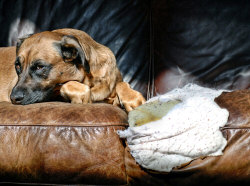 There are many signs to tell if your dog has separation anxiety by watching your
dog’s behavior. Separation anxiety is an animal’s fear over separation from its
owners. Your dog is afraid of being left alone. Is your dog extremely attached
to you, wanting to cuddle and always be around you? Your dog may always worry,
bark, and/or yelp when you leave. Destroying objects, wanting to over eat or
under eat, urinating or defecating in the house or inappropriately, salivating,
panting, pacing, vomiting, or having diarrhea are signs of separation anxiety.
They may also show depression or aggressiveness when you are getting ready to
leave the house. If your dog has bad enough separation anxiety they may try to
escape. Escaping may usually result in damages or self injury especially when
dealing with windows, doors, window air conditioners, and points of exit. They
will try to chew through, scratch through, or break through anything no matter
the potential pain it may cause them. They will try to get out of the situation
of being left alone in the space you left them in. You often see these signs in
a puppy but they should go away in time sooner than later. If your dog is
getting older and never losing these symptoms you need to start training them to
work on lessening or losing their separation anxiety. There are many signs to tell if your dog has separation anxiety by watching your
dog’s behavior. Separation anxiety is an animal’s fear over separation from its
owners. Your dog is afraid of being left alone. Is your dog extremely attached
to you, wanting to cuddle and always be around you? Your dog may always worry,
bark, and/or yelp when you leave. Destroying objects, wanting to over eat or
under eat, urinating or defecating in the house or inappropriately, salivating,
panting, pacing, vomiting, or having diarrhea are signs of separation anxiety.
They may also show depression or aggressiveness when you are getting ready to
leave the house. If your dog has bad enough separation anxiety they may try to
escape. Escaping may usually result in damages or self injury especially when
dealing with windows, doors, window air conditioners, and points of exit. They
will try to chew through, scratch through, or break through anything no matter
the potential pain it may cause them. They will try to get out of the situation
of being left alone in the space you left them in. You often see these signs in
a puppy but they should go away in time sooner than later. If your dog is
getting older and never losing these symptoms you need to start training them to
work on lessening or losing their separation anxiety.
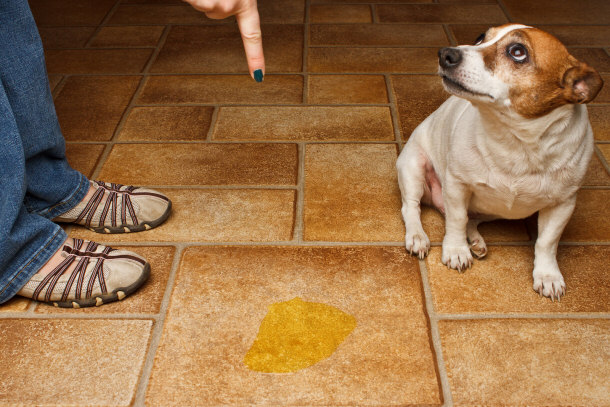
Your dog is thinking they are about to lose their best friend and they are
never coming back. There is no known cause of why dogs develop separation
anxiety, but there are ways to try and help to fix the situation. The main point
in fixing your dog’s separation anxiety is to solve the dogs underlying issue;
dogs are social animals so they will always want to be around you. You want to
teach the dog to enjoy or be able to tolerate being left alone without being
stressed or having anxiety. Knowing that you are going to come back to them is
key to fixing separation anxiety issues.
Things That Can Trigger Separation Anxiety in Your Dog
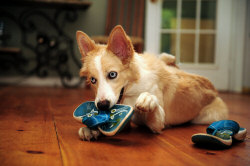 Things that can trigger separation anxiety are changes in schedule, moving
homes, switching owners, etc; Ways to work on fixing separation anxiety include
putting your dog in a smaller area so they feel more secure. Positive
reinforcement tends to work with dogs giving them a treat or verbal praise, and
you want to ignore the dog’s bad behavior. Ignoring the dog’s bad behavior is
positive because to you, you think you are showing the dog that you do not like
what they did, and you are punishing them. To some dogs this is not the case. To
some dogs they are searching for the attention from you, so even verbally
reprimanding the dog makes the dog happy because they are being noticed by you. Things that can trigger separation anxiety are changes in schedule, moving
homes, switching owners, etc; Ways to work on fixing separation anxiety include
putting your dog in a smaller area so they feel more secure. Positive
reinforcement tends to work with dogs giving them a treat or verbal praise, and
you want to ignore the dog’s bad behavior. Ignoring the dog’s bad behavior is
positive because to you, you think you are showing the dog that you do not like
what they did, and you are punishing them. To some dogs this is not the case. To
some dogs they are searching for the attention from you, so even verbally
reprimanding the dog makes the dog happy because they are being noticed by you.
Start small by leaving the dog in a room with you, hangout with them in the
room for a short period of time, then make your way and slip out leaving them in
the room alone. The dog will think they are being left alone. Next after only
waiting for a short period of time, go back and get them to show them you did
not leave. As you continue to work with leaving your dog in the room alone
increase the time you leave the dog alone. You could also try doing things you
would normally do when you are getting ready to leave the house. Get your keys,
get dressed, and put your shoes on so the dog thinks you are actually leaving
the house. Doing this over and over will hopefully show your dog that you are
going to come back. You can also spend less time with your dog at other times of
the day during your training. Use less eye contact, less verbal praise, and less
time comforting them. It is also important to have your dog sleep in another
room if it usually sleeps in your bed or bedroom. This will help decrease the
dog’s strong attachment to you by showing them that they do not have to be
around you at all moments of the day.
Man's Best Friend
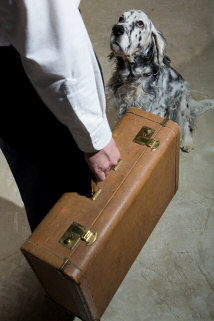 Some dogs can tell ten to twenty minutes before you are even thinking about
getting ready to leave the house. Some will try to prevent you from leaving by
getting aggressive or depressed. A way you can try to prevent this from
happening is to say your goodbyes a half hour before you actually leave the
house. Start to ignore the dog for twenty to thirty minutes, instead of giving
the dog extra love because you feel guilty about leaving them. Another help for
the situation is making sure your dog gets the right amount of exercise.
Exercise will help your dog calm down and not feel as up tight, help them rest
more calmly, and be less fretful when left alone. You can try putting something
in the cage with your dog when you leave that smells like you for the dog to
feel more comforted, just like you are there with them. You could also leave the
radio or TV on so the dog does not hear complete silence; the noise may be
comforting to them. Do not make a big deal of coming and going, this will show
the dog that it is not a big deal to you about the time you guys were apart, and
it is not a big deal for you to come and go. Making a big deal of coming and
going from home will reward the dog's concern about you coming or going. Before
you leave the house try to leave the guilty, concerned, and nervous feelings
behind. Bring out the confidence you have as the pack leader as you need to be
assertive and calm in the hope that your dog can sense this in you. It will soon
ease your dog’s separation anxiety. You could purchase a Thundershirt for your
dog, which is a vest that goes around the dog that would comfort them further.
It comforts them because it applies pressure, which is said to help relieve
anxiety. Some dogs can tell ten to twenty minutes before you are even thinking about
getting ready to leave the house. Some will try to prevent you from leaving by
getting aggressive or depressed. A way you can try to prevent this from
happening is to say your goodbyes a half hour before you actually leave the
house. Start to ignore the dog for twenty to thirty minutes, instead of giving
the dog extra love because you feel guilty about leaving them. Another help for
the situation is making sure your dog gets the right amount of exercise.
Exercise will help your dog calm down and not feel as up tight, help them rest
more calmly, and be less fretful when left alone. You can try putting something
in the cage with your dog when you leave that smells like you for the dog to
feel more comforted, just like you are there with them. You could also leave the
radio or TV on so the dog does not hear complete silence; the noise may be
comforting to them. Do not make a big deal of coming and going, this will show
the dog that it is not a big deal to you about the time you guys were apart, and
it is not a big deal for you to come and go. Making a big deal of coming and
going from home will reward the dog's concern about you coming or going. Before
you leave the house try to leave the guilty, concerned, and nervous feelings
behind. Bring out the confidence you have as the pack leader as you need to be
assertive and calm in the hope that your dog can sense this in you. It will soon
ease your dog’s separation anxiety. You could purchase a Thundershirt for your
dog, which is a vest that goes around the dog that would comfort them further.
It comforts them because it applies pressure, which is said to help relieve
anxiety.

When to Consult the Vet
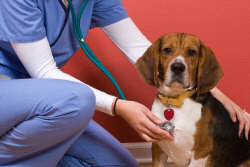 If none of the above suggestions work, I would suggest turning to the use of
medication to help calm your dog down and get rid of the anxiety. Before turning
to the use of medication, I would suggest to consult your vet for the proper
medication to use. When your dog is losing its separation anxiety you will
notice changes in your dog such as being less tense, more carefree, less
depressed, and more enthusiastic. During this training remember patience is the
key. Your dog is not doing things to misbehave and make you mad, they are doing
it because they are scared and unsure of you. They believe that their best
friend and companion is leaving them and never coming back. If none of the above suggestions work, I would suggest turning to the use of
medication to help calm your dog down and get rid of the anxiety. Before turning
to the use of medication, I would suggest to consult your vet for the proper
medication to use. When your dog is losing its separation anxiety you will
notice changes in your dog such as being less tense, more carefree, less
depressed, and more enthusiastic. During this training remember patience is the
key. Your dog is not doing things to misbehave and make you mad, they are doing
it because they are scared and unsure of you. They believe that their best
friend and companion is leaving them and never coming back.
Pets
Top Lists:
18 Richest Animals in the World
15 Exotic Pets You Could Own Today
Top 20 Common Substances That Are Toxic to Cats and Dogs
Informational:
Animal Actors: Pets in the Film, TV, and Print Industry
Caring for a Yorkshire Terrier: Facts You Should Know
Caring for a Pig as a Pet: The Pot-bellied Pig and the Micro Pig
Difference Between a Cat Person And a Dog Person
Should You Microchip your Cat or Dog?
How to Raise and Care for Pygmy Goats
Caring for Unique Pets: The Leopard Gecko
Use Food-Grade Diatomaceous Earth to Kill Fleas Naturally
Dogs:
Top Lists:
Top 15 Dog Breeds For Home Protection
15 Fascinating Facts About The Mastiff
Informational:
How To Teach Your Dog to Hunt for Truffles
Caring for an English Bulldog: Tips and Basic Info
Cranial Cruciate Ligament (CCL) Tears in Dogs: Treating the Injury
How To Keep Your Dog free of Heartworm Disease
Dog With Separation Anxiety?
Cats:
Top Lists:
Top 6 Qualities in an Awesome Cat
Informational:
How to Control Fighting Felines
How to Get Your Cat to Exercise
Fish:
Fish 101 for the Hobbyist: The Fish’s Body and Senses
Buying a Saltwater Aquarium: What You Need to Know
Graduating to a Saltwater Tank
|